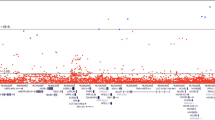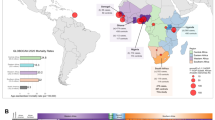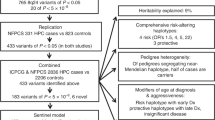Abstract
Apoptosis is an essential physiological process that regulates cellular proliferation. Here, we explored the effect of DNA sequence variation within the BCL-2 gene on prostate cancer susceptibility in three clinical populations, consisting of 428 African Americans, 214 Jamaicans and 218 European Americans. We observed a 70% reduced risk for prostate cancer among the European Americans who had possessed two copies of a promoter variant −938C/A. Additionally, common BCL-2 haplotypes appeared to influence prostate cancer risk; however, studies in larger data sets are needed to confirm our findings. Our data suggest that inherited BCL-2 variants may be associated with a decrease in prostate cancer susceptibility.
This is a preview of subscription content, access via your institution
Access options
Subscribe to this journal
Receive 4 print issues and online access
$259.00 per year
only $64.75 per issue
Buy this article
- Purchase on Springer Link
- Instant access to full article PDF
Prices may be subject to local taxes which are calculated during checkout


Similar content being viewed by others
References
American Cancer Society. Factors that influence cancer rates. Cancer Fact and Figures 2005 2005, 59–60.
Glover Jr FE, Coffey DS, Douglas LL, Cadogan M, Russell H, Tulloch T et al. The epidemiology of prostate cancer in Jamaica. J Urol 1998; 159: 1984–1986.
Tang DG, Porter AT . Target to apoptosis: a hopeful weapon for prostate cancer. Prostate 1997; 32: 284–293.
Tsujimoto Y, Bashir MM, Givol I, Cossman J, Jaffe E, Croce CM . DNA rearrangements in human follicular lymphoma can involve the 5′ or the 3′ region of the bcl-2 gene. Proc Natl Acad Sci USA 1987; 84: 1329–1331.
Tapia-Vieyra JV, Mas-Oliva J . Apoptosis and cell death channels in prostate cancer. Arch Med Res 2001; 32: 175–185.
Oltvai ZN, Milliman CL, Korsmeyer SJ . Bcl-2 heterodimerizes in vivo with a conserved homolog, Bax, that accelerates programmed cell death. Cell 1993; 74: 609–619.
Wang K, Gross A, Waksman G, Korsmeyer SJ . Mutagenesis of the BH3 domain of BAX identifies residues critical for dimerization and killing. Mol Cell Biol 1998; 18: 6083–6089.
Baliga BC, Kumar S . Role of Bcl-2 family of proteins in malignancy. Hematol Oncol 2002; 20: 63–74.
Cory S, Adams JM . The Bcl2 family: regulators of the cellular life-or-death switch. Nat Rev Cancer 2002; 2: 647–656.
Reed JC . Mechanisms of apoptosis. Am J Pathol 2000; 157: 1415–1430.
Petros AM, Nettesheim DG, Wang Y, Olejniczak ET, Meadows RP, Mack J et al. Rationale for Bcl-xL/Bad peptide complex formation from structure, mutagenesis, and biophysical studies. Protein Sci 2000; 9: 2528–2534.
Sattler M, Liang H, Nettesheim D, Meadows RP, Harlan JE, Eberstadt M et al. Structure of Bcl-xL–Bak peptide complex: recognition between regulators of apoptosis. Science 1997; 275: 983–986.
Bonkhoff H, Remberger K . Differentiation pathways and histogenetic aspects of normal and abnormal prostatic growth: a stem cell model. Prostate 1996; 28: 98–106.
Johnson MI, Robinson MC, Marsh C, Robson CN, Neal DE, Hamdy FC . Expression of Bcl-2, Bax, and p53 in high-grade prostatic intraepithelial neoplasia and localized prostate cancer: relationship with apoptosis and proliferation. Prostate 1998; 37: 223–229.
Kaur P, Kallakury BS, Sheehan CE, Fisher HA, Kaufman RP, Ross JS . Survivin and Bcl-2 expression in prostatic adenocarcinomas. Arch Pathol Lab Med 2004; 128: 39–43.
Hering FL, Lipay MV, Lipay MA, Rodrigues PR, Nesralah LJ, Srougi M . Comparison of positivity frequency of bcl-2 expression in prostate adenocarcinoma with low and high Gleason score. Sao Paulo Med J 2001; 119: 138–141.
Bonkhoff H, Fixemer T, Remberger K . Relation between Bcl-2, cell proliferation, and the androgen receptor status in prostate tissue and precursors of prostate cancer. Prostate 1998; 34: 251–258.
Colombel M, Symmans F, Gil S, O'Toole KM, Chopin D, Benson M et al. Detection of the apoptosis-suppressing oncoprotein bc1-2 in hormone-refractory human prostate cancers. Am J Pathol 1993; 143: 390–400.
Lipponen P, Vesalainen S . Expression of the apoptosis suppressing protein bcl-2 in prostatic adenocarcinoma is related to tumor malignancy. Prostate 1997; 32: 9–15.
McConkey DJ, Greene G, Pettaway CA . Apoptosis resistance increases with metastatic potential in cells of the human LNCaP prostate carcinoma line. Cancer Res 1996; 56: 5594–5599.
Lang G, Gombert WM, Gould HJ . A transcriptional regulatory element in the coding sequence of the human Bcl-2 gene. Immunology 2005; 114: 25–36.
Grabe N . AliBaba2: context specific identification of transcription factor binding sites. In Silico Biol 2002; 2: S1–S15.
Kittles RA, Young D, Weinrich S, Hudson J, Argyropoulos G, Ukoli F et al. Extent of linkage disequilibrium between the androgen receptor gene CAG and GGC repeats in human populations: implications for the prostate cancer risk. Cancer Risk 2001; 109: 253–261.
Panguluri R, Chen W, Kittles R . SNP genotyping of candidate genes for complex diseases using pyrosequencing. Am Biotechnol Lab 2002; 20: 30–34.
Satten GA, Epstein MP . Comparison of prospective and retrospective methods for haplotype inference in case–control studies. Genet Epidemiol 2004; 27: 192–201.
Keshgegian AA, Johnston E, Cnaan A . Bcl-2 oncoprotein positivity and high MIB-1 (Ki-67) proliferative rate are independent predictive markers for recurrence in prostate carcinoma. Am J Clin Pathol 1998; 110: 443–449.
Sinicrope FA, Hart J, Michelassi F, Lee JJ . Prognostic value of bcl-2 oncoprotein expression in stage II colon carcinoma. Clin Cancer Res 1995; 1: 1103–1110.
Anton RC, Brown RW, Younes M, Gondo MM, Stephenson MA, Cagle PT . Absence of prognostic significance of bcl-2 immunopositivity in non-small cell lung cancer: analysis of 427 cases. Hum Pathol 1997; 28: 1079–1082.
aka-Akita H, Katabami M, Hommura H, Fujioka Y, Katoh H, Kawakami Y . Bcl-2 expression in non-small cell lung cancers: higher frequency of expression in squamous cell carcinomas with earlier pT status. Oncology 1999; 56: 259–264.
Meterissian SH, Kontogiannea M, Al-Sowaidi M, Linjawi A, Halwani F, Jamison B et al. Bcl-2 is a useful prognostic marker in Dukes' B colon cancer. Ann Surg Oncol 2001; 8: 533–537.
Nakamura T, Nomura S, Sakai T, Nariya S . Expression of bcl-2 oncoprotein in gastrointestinal and uterine carcinomas and their premalignant lesions. Hum Pathol 1997; 28: 309–315.
Stattin P . Prognostic factors in prostate cancer. Scand J Urol Nephrol Suppl 1997; 185: 1–46.
Lu QL, Abel P, Foster CS, Lalani EN . bcl-2: role in epithelial differentiation and oncogenesis. Hum Pathol 1996; 27: 102–110.
McDonnell TJ, Troncoso P, Brisbay SM, Logothetis C, Chung LW, Hsieh JT et al. Expression of the protooncogene bcl-2 in the prostate and its association with emergence of androgen-independent prostate cancer. Cancer Res 1992; 52: 6940–6944.
Kallakury BV, Figge J, Leibovich B, Hwang J, Rifkin M, Kaufman R et al. Increased bcl-2 protein levels in prostatic adenocarcinomas are not associated with rearrangements in the 2.8 kb major breakpoint region or with p53 protein accumulation. Mod Pathol 1996; 9: 41–47.
Bauer JJ, Sesterhenn IA, Mostofi FK, McLeod DG, Srivastava S, Moul JW . Elevated levels of apoptosis regulator proteins p53 and bcl-2 are independent prognostic biomarkers in surgically treated clinically localized prostate cancer. J Urol 1996; 156: 1511–1516.
Wilson BE, Mochon E, Boxer LM . Induction of bcl-2 expression by phosphorylated CREB proteins during B-cell activation and rescue from apoptosis. Mol Cell Biol 1996; 16: 5546–5556.
Heckman CA, Mehew JW, Boxer LM . NF-kappaB activates Bcl-2 expression in t(14;18) lymphoma cells. Oncogene 2002; 21: 3898–3908.
Xie W, Wong YC, Tsao SW . Correlation of increased apoptosis and proliferation with development of prostatic intraepithelial neoplasia (PIN) in ventral prostate of the Noble rat. Prostate 2000; 44: 31–39.
Kaklamanis L, Savage A, Mortensen N, Tsiotos P, Doussis-Anagnostopoulou I, Biddolph S et al. Early expression of bcl-2 protein in the adenoma–carcinoma sequence of colorectal neoplasia. J Pathol 1996; 179: 10–14.
Ter B, Smedts F, Kuijpers J, Jeunink M, Trimbos B, Ramaekers F . BCL-2 immunoreactivity increases with severity of CIN: a study of normal cervical epithelia, CIN, and cervical carcinoma. J Pathol 1996; 179: 26–30.
Royuela M, De Miguel MP, Bethencourt FR, Fraile B, Arenas MI, Paniagua R . IL-2, its receptors, and bcl-2 and bax genes in normal, hyperplastic and carcinomatous human prostates: immunohistochemical comparative analysis. Growth Factors 2000; 18: 135–146.
Chi KN, Gleave ME . Antisense approaches in prostate cancer. Expert Opin Biol Ther 2004; 4: 927–936.
Acknowledgements
We thank all the men who volunteered to participate in this genetic study. This work was supported by the NIH (1U54CA91431-01), the Department of Defense (DAMD17-00-1-0025 and DAMD 17-02-1-0067) and the Howard University Cancer Center.
Author information
Authors and Affiliations
Corresponding author
Rights and permissions
About this article
Cite this article
Kidd, L., Coulibaly, A., Templeton, T. et al. Germline BCL-2 sequence variants and inherited predisposition to prostate cancer. Prostate Cancer Prostatic Dis 9, 284–292 (2006). https://doi.org/10.1038/sj.pcan.4500884
Received:
Accepted:
Published:
Issue Date:
DOI: https://doi.org/10.1038/sj.pcan.4500884
Keywords
This article is cited by
-
Association of BCL2-938C>A genetic polymorphism with glioma risk in Chinese Han population
Tumor Biology (2014)
-
Interaction among apoptosis-associated sequence variants and joint effects on aggressive prostate cancer
BMC Medical Genomics (2012)
-
The -938A/A genotype of BCL2 gene is associated with esophageal cancer
Medical Oncology (2012)



